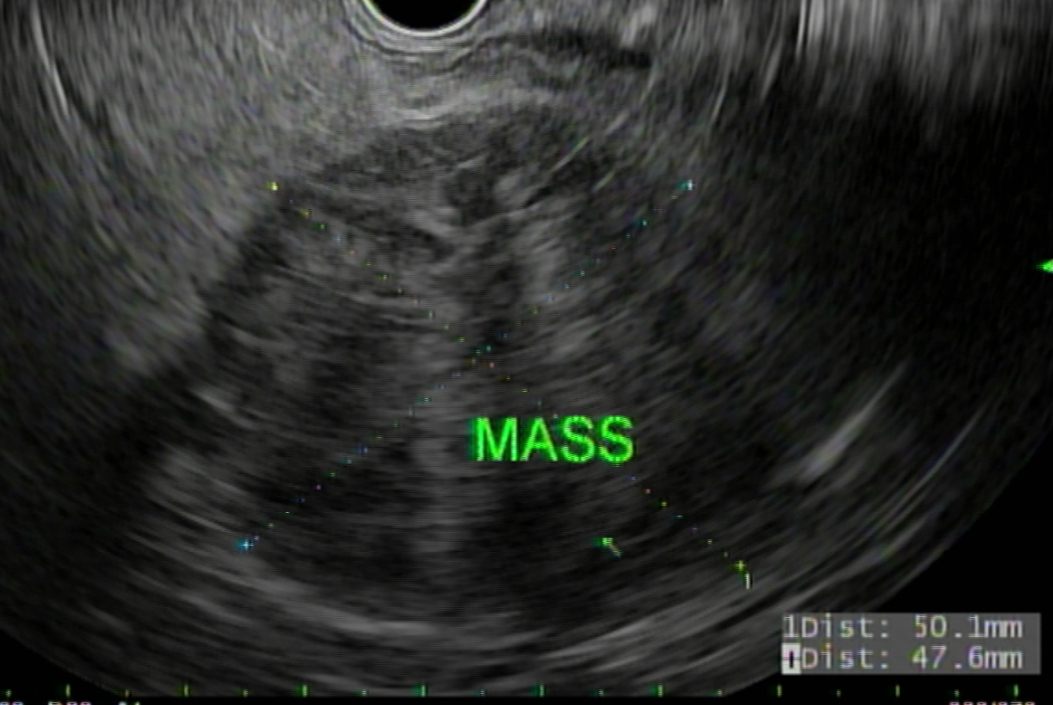Tuesday Poster Session
Category: Biliary/Pancreas
P4379 - Solid Pseudopapillary Neoplasm of the Pancreas Presenting as Acute Back Pain: A Rare Clinical Manifestation
Tuesday, October 28, 2025
10:30 AM - 4:00 PM PDT
Location: Exhibit Hall

Mutaz Kalas, MD
Texas Tech University Health Science Center El Paso
El Paso, TX
Presenting Author(s)
Mutaz Kalas, MD1, Shivangini Duggal, MD2, Jesus Guzman, MD3, Sherif E. Elhanafi, MD4
1Texas Tech University Health Science Center El Paso, El Paso, TX; 2Department of Internal Medicine at Paul L. Foster School of Medicine, Texas Tech University Health Sciences Center, El Paso TX, USA, El Paso, TX; 3Division of Gastroenterology, Department of Internal Medicine, Texas Tech University Health Sciences Center, El Paso, TX., El Paso, TX; 4Texas Tech University Health Sciences Center, El Paso, TX
Introduction: Solid pseudopapillary neoplasms (SPNs) are rare, low-grade malignant tumors of the pancreas comprising 1–2% of pancreatic neoplasms. Predominantly affecting young women, these tumors are typically slow-growing and often discovered incidentally during imaging for nonspecific symptoms. While abdominal discomfort is the most common presentation, acute back pain is an unusual manifestation. We present a case of a young female who presented with acute back pain and was found to have a pancreatic tail SPN.
Case Description/
Methods: We report the case of a 23-year-old woman with no significant medical history who presented with acute lower back pain and nonbilious emesis. Laboratory evaluation, including pancreatic enzymes, was unremarkable. A non-contrast abdominal CT scan revealed a 5.7 × 4.7 × 4.2 cm mass in the pancreatic tail, with historical imaging from 2018 showing a smaller lesion in the same region. MRI and endoscopic ultrasound confirmed a 5 cm solid mass without lymphadenopathy or ductal dilation. EUS-guided fine needle biopsy showed immunohistochemical staining positive for synaptophysin, CD10, and nuclear β-catenin, consistent with SPN. The patient underwent robotic distal pancreatectomy, splenectomy, and partial omentectomy. Surgical pathology confirmed a confined SPN without lymphovascular or perineural invasion. She recovered well and was discharged with multidisciplinary outpatient follow-up.
Discussion: This case highlights a rare presentation of solid pseudopapillary neoplasm (SPN) as acute back pain, reflecting its indolent course and potential for delayed diagnosis. It is important to consider this uncommon entity in the differential diagnosis, even in atypical clinical scenarios, as early recognition can facilitate timely management and improve patient outcomes. Although SPNs have low malignant potential, surgical resection is warranted due to the risk of metastasis. Prognosis following complete resection is excellent, with an estimated 5-year survival rate of 97%.

Figure: EUS: 50 x 47 mm hypoechoic mass in the pancreatic tail.

Figure: MRI Abdomen: 4.7 x 5.1 cm solid mass within the tail of the pancreas.
Disclosures:
Mutaz Kalas indicated no relevant financial relationships.
Shivangini Duggal indicated no relevant financial relationships.
Jesus Guzman indicated no relevant financial relationships.
Sherif Elhanafi indicated no relevant financial relationships.
Mutaz Kalas, MD1, Shivangini Duggal, MD2, Jesus Guzman, MD3, Sherif E. Elhanafi, MD4. P4379 - Solid Pseudopapillary Neoplasm of the Pancreas Presenting as Acute Back Pain: A Rare Clinical Manifestation, ACG 2025 Annual Scientific Meeting Abstracts. Phoenix, AZ: American College of Gastroenterology.
1Texas Tech University Health Science Center El Paso, El Paso, TX; 2Department of Internal Medicine at Paul L. Foster School of Medicine, Texas Tech University Health Sciences Center, El Paso TX, USA, El Paso, TX; 3Division of Gastroenterology, Department of Internal Medicine, Texas Tech University Health Sciences Center, El Paso, TX., El Paso, TX; 4Texas Tech University Health Sciences Center, El Paso, TX
Introduction: Solid pseudopapillary neoplasms (SPNs) are rare, low-grade malignant tumors of the pancreas comprising 1–2% of pancreatic neoplasms. Predominantly affecting young women, these tumors are typically slow-growing and often discovered incidentally during imaging for nonspecific symptoms. While abdominal discomfort is the most common presentation, acute back pain is an unusual manifestation. We present a case of a young female who presented with acute back pain and was found to have a pancreatic tail SPN.
Case Description/
Methods: We report the case of a 23-year-old woman with no significant medical history who presented with acute lower back pain and nonbilious emesis. Laboratory evaluation, including pancreatic enzymes, was unremarkable. A non-contrast abdominal CT scan revealed a 5.7 × 4.7 × 4.2 cm mass in the pancreatic tail, with historical imaging from 2018 showing a smaller lesion in the same region. MRI and endoscopic ultrasound confirmed a 5 cm solid mass without lymphadenopathy or ductal dilation. EUS-guided fine needle biopsy showed immunohistochemical staining positive for synaptophysin, CD10, and nuclear β-catenin, consistent with SPN. The patient underwent robotic distal pancreatectomy, splenectomy, and partial omentectomy. Surgical pathology confirmed a confined SPN without lymphovascular or perineural invasion. She recovered well and was discharged with multidisciplinary outpatient follow-up.
Discussion: This case highlights a rare presentation of solid pseudopapillary neoplasm (SPN) as acute back pain, reflecting its indolent course and potential for delayed diagnosis. It is important to consider this uncommon entity in the differential diagnosis, even in atypical clinical scenarios, as early recognition can facilitate timely management and improve patient outcomes. Although SPNs have low malignant potential, surgical resection is warranted due to the risk of metastasis. Prognosis following complete resection is excellent, with an estimated 5-year survival rate of 97%.

Figure: EUS: 50 x 47 mm hypoechoic mass in the pancreatic tail.

Figure: MRI Abdomen: 4.7 x 5.1 cm solid mass within the tail of the pancreas.
Disclosures:
Mutaz Kalas indicated no relevant financial relationships.
Shivangini Duggal indicated no relevant financial relationships.
Jesus Guzman indicated no relevant financial relationships.
Sherif Elhanafi indicated no relevant financial relationships.
Mutaz Kalas, MD1, Shivangini Duggal, MD2, Jesus Guzman, MD3, Sherif E. Elhanafi, MD4. P4379 - Solid Pseudopapillary Neoplasm of the Pancreas Presenting as Acute Back Pain: A Rare Clinical Manifestation, ACG 2025 Annual Scientific Meeting Abstracts. Phoenix, AZ: American College of Gastroenterology.
